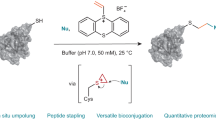
5-5′’-Dithio-bis(2-nitrobenzoic acid) (DTNB or Ellman’s reagent; ref. 1) reacts with the free sulfhydryl side chain of cysteine to form an S-S bond between the protein and a thionitrobenzoic acid (TNB) residue. The modification is generally rapid and selective. The main advantage of DTNB over alternative reagents (e.g., N-ethylmaleimide or iodoacetamide) is in the selectivity of this reagent and in the ability to follow the course of the reaction spectrophotometrically. The reaction is usually performed at pH 7.0-8.0 and the modification is stable under oxidative conditions. The TNB group can be released from modified protein by treatment with reagents that are routinely used to reduce S-S bonds, for example, mercaptoethanol, or by potassium cyanide (2) (see Note 1). In addition, the often highly pronounced differences in reactivity of different cysteine side chains in the same protein or even active site, and the availability of a variety of thiol-modifying reagents can be exploited to selectively modify cysteine side chains in proteins in the presence of other, more reactive cysteine residues (3).
This is a preview of subscription content, log in via an institution to check access.

Article Open access 20 December 2023